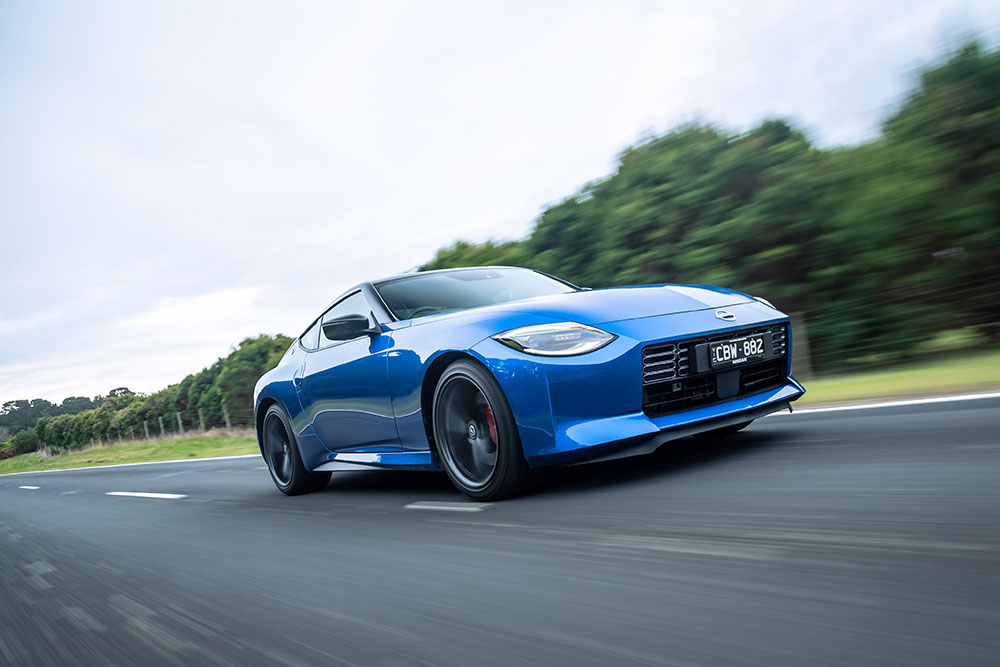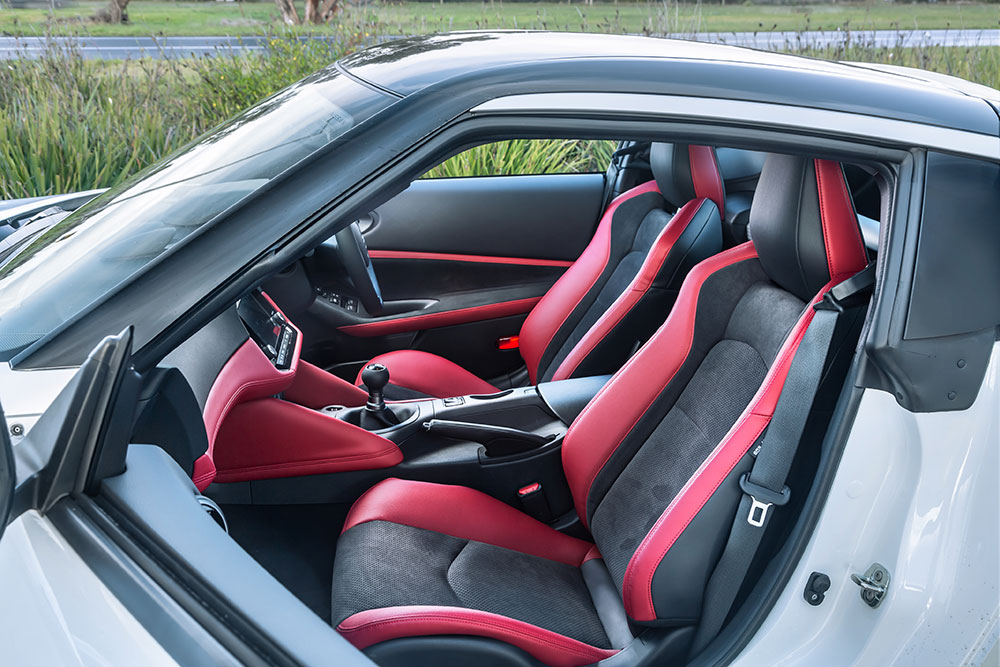Nissan Z Coupe review
With its eye-catching styling, keen dynamics and punchy performance, the new Nissan Z Coupe has all the ingredients of a tasty sports car offering.

The ‘Zenith of Z-ness for Z-enthusiasts’ is not some tongue twister from a Dr. Seuss book but a phrase used by Nissan’s former Z chief product specialist, Hiroshi Tamura, in the foreword to Pete Evanow’s 2021 tome Nissan Z: 50 Years of Exhilarating Performance.
While Evanow might not be widely known outside his usual motorsports, marketing and public relations roles, among Nissan enthusiasts Tamura-san is revered as the engineering doyen of the Z and its bigger, badder brother the GT-R.
The enthusiastic former chief engineer was on hand at the local launch of the new Z to regale Aussie journos with tales of how the sports car he holds so dear has evolved, over the course of 50-plus years and seven generations.
These days Tamura-san carries a business card describing him as ‘Brand Ambassador Product Planning Department’, which is a polite way of saying he’s officially retired, but unofficially he remains a key cog in Nissan’s global PR rollout of the new Z.
The polite, smiling 60-something has likely done more than any single person to guide this seventh-generation Z through its difficult gestation period, including championing it at every level within the organisation and refusing to allow the bean counters to kill it off.
That was surely no easy task, given the notoriously fragile platform on which sports car business cases are often built.
Fortunately, Tamura-san prevailed and Australia is one of just three markets worldwide to get the new Z, the others being the USA and its Japanese home market.
That’s partly due to the fact this country is one of only a handful to have embraced each and every generation of the Japanese sports car, so you could say our loyalty is being rewarded. But it’s also to do with tightening emissions standards in markets such as the UK, where the new Z is not compliant.
Nevertheless, Australia’s unbroken association with the slinky rear-wheel coupe seems to have infused its distinctive lines into our collective automotive consciousness, as evidenced by the regular thumbs-up in traffic and the steady stream of curious onlookers keen to take a closer look during our two-day test drive on Victoria’s picturesque Mornington Peninsula.
Nissan’s faith in Australia’s appetite for sports and performance cars appears to have been vindicated already, at least if sales of the Z Proto Spec are anything to go by.
.jpg?rev=6ceb6288450d47389332c5d7dc7914eb&hash=7F58395124F403F486076C0FD4E58897)
The limited-edition model sold out in record time when the order books were opened just weeks before the new Z’s official launch, despite costing $7,000 more than the regular variants.
While the Z Proto is no longer available, the Z Coupe comes in a single specification level, equipped with either a nine-speed paddle-shift automatic, or a six-speed manual.
Both transmissions are priced identically at $73,300 (MRLP) and both are powered by a muscular 3.0-litre twin-turbocharged V6, punching out a healthy 298kW/475Nm.
These figures compare favourably with the Z’s immediate rivals, including Toyota’s Supra which extracts 285kW/500Nm from its turbocharged inline 3.0-litre six-cylinder and the muscular 339kW/556Nm of Ford’s 5.0-litre V8 powered Mustang.
The Z’s price is also carefully calibrated to come in under the base Supra GT’s $87,303 and give pause to Mustang V8 buyers shopping in its $65,290 to $77,990 price band.
Nissan claims the manual will be the preferred choice of about 70% of early adopters, although it expects the auto to gain in popularity as the Z moves through its product cycle.
Both transmissions come standard with launch control and a rear limited slip diff, both of which were demonstrated to good effect on a closed airstrip during the launch.
Your correspondent can report that the effect of ‘sending it’ at full velocity feels more dramatic in the auto than the manual, perhaps because you’re not engaged in modulating throttle and gearshift so there’s more of a shock when the engine’s full power is sent rearwards.
That said, a full-blooded launch is seriously attention grabbing in either version with the 275/35R19 Bridgestone Potenza rear tyres struggling to harness the engine’s prodigious torque.
The automatic is a smooth, effortless and quick shifting proposition that’s probably ultimately the quicker of the two thanks to its three extra ratios and standard Sport mode, although for drivers wanting a more engaged driving experience the manual has a direct action and a nice short throw.
It comes teamed with a high-performance Exedy clutch that’s progressive and positive on take up.

Out on the road the manual ticks over about 2100rpm at 100km/h, at which point there’s ample torque available for strong acceleration without a downshift.
Not that you’ll mind shifting, as the close-ratio gearbox is nicely precise and the V6 issues an intoxicating note when prodded, complete with rev-matching auto throttle blips on downshifts.
With peak torque arriving at just 1800rpm there’s no need to rev the engine particularly hard, but it spins up eagerly and stretches all the way to its 6400rpm power peak when tasked.
Knock it back a cog or two and nail the throttle and it reveals some serious mid-range muscle with the ability to easily loosen the grip of the rear tyres as the turbos boost up.
Interestingly, Nissan declined to provide a 0-100km/h claim for its new model, saying instead that it preferred to allow individual media outlets to form their own opinion.
We haven’t run the numbers ourselves but magazines and websites in the US have recorded times of 4.5 seconds, which is a few tenths off the 4.1 seconds of its main rival the Toyota Supra and on the money of Ford’s V8 Mustang.
Certainly, the new Z is quick enough to raise pulses and smiles, which is largely the point.
The styling of this new model gives some obvious nods to its famous predecessors, including the 240Z and the 300ZX, with that same poised-to-pounce stance that makes it seem instantly familiar, despite being entirely new.
The classic long nose, short deck and powerful wheel arches are all essential elements of previous Z models, but the sophisticated design and detailing of this new Z ensures it avoids being a pastiche of its predecessors.
Arguably its most polarising element is the gaping maw of a mouth which goes against the current EV-led trend to eschew grilles altogether.
.jpg?rev=7dd6ed0669b74c76b0e5078dcc9d9499&hash=27A41505017EE163B7C6706D31744798)
Once again, it’s a throwback to the 240Z but in this instance serves the practical purpose of feeding air to the new, more sophisticated and more powerful turbocharged and intercooled powerplant.
Perhaps unsurprisingly, getting in and out of the low-slung cabin presents some small challenges, and you need to watch your head on the plunging roofline, especially when exiting.
Of course, such compromises come with the sports car territory, as does the fact it’s a dedicated two-seater with a relatively small luggage area, although there’s space for a pair of cabin baggage sized suitcases and a couple of smaller day packs back there.
You slide in behind a nice thick, leather-trimmed steering wheel and drop into electric adjusted leather-accented sports seats.
The driving position is comfortable, although anyone taller than 183cm or with especially long legs might find there’s not quite enough seat reach adjustment.
Bigger frames may also find their thighs interfere with the steering wheel, so be sure to try a ‘Z’ on for size before putting your money down.
Ahead of the driver is a customisable 12.3-inch TFT digital dash display, while an 8.0-inch infotainment screen at the centre of the dash provides Android Auto and Apple Car Play integration.
There’s no native sat nav, which might irk some buyers at this price, but Nissan believes customers will be happy using the ubiquitous smartphone to navigate.
A trio of race-inspired gauges protruding above the dash and angling back towards the driver are another retro-race cue.
They offer most of the same info that’s available in the digital dash menus, but the blistered gauge pod certainly looks the part.
Standard equipment includes an eight-speaker BOSE sound system, aluminium pedals, Z-branded kick plates, heated electric seats, power folding and heated door mirrors, auto-levelling LED headlights and two cupholders in lieu of the old model’s single unit, to avoid in-cabin arguments.
Safety is well catered for, too, with five airbags and a range of active safety features including AEB with pedestrian detection, forward collision warning, lane departure warning, rear cross-traffic alert, high beam assist and blind spot monitoring. There’s also front and rear parking sensors and a rear camera.
.jpg?rev=bdc5d1d99d674fe68dabb92f436bafa2&hash=C565A4EA3C7E8F293096A66135A298D9)
Dynamically, the Z feels as precise and agile as its form suggests, thanks to double wishbone front and multilink rear suspension, both made from lightweight aluminium to keep unsprung mass down.
The new rack assist electric power steering is nicely direct without being nervous and the ride is pleasingly compliant, but not so soft as to be detrimental to handling.
There was some discussion among scribes at the launch about whether the suspension was too soft for the Z’s sports car positioning, with some believing it should be firmer with more scalpel-like in its dynamics.
Your correspondent begs to differ, particularly light of the fact that Nissan already has the much more hardcore GT-R in its performance car arsenal, so doesn’t need two such machines.
It’s true that you can’t push a Z through corners with the pace and surety of the brutishly fast and far less forgiving GT-R, but its handling limits are such that it’ll satisfy all but the most demanding of enthusiasts, while also being an enjoyable daily driver.
Braking performance from the four-wheel ventilated discs is powerful and progressive, with consistent feedback and good pedal feel when you lean hard on them. The electronic stability and traction control systems are tuned to allow a bit more rear wheel slip than you’ll find in more sedate models, allowing the tail to step out momentarily when provoked. Give the manual a boot in the wet and it will momentarily break traction and step sideways before the ESC kicks in, which only adds to the exhilaration of the drive.
At the time of the launch Nissan claimed to have had 2700 customers come through its ‘reserve your car’ process and to have taken 1200 deposits, with the company’s MD Adam Paterson saying he hoped to have the firm orders delivered by end of March. However, he wouldn’t commit or guarantee that timeline due to the vagaries of the supply chain at present.
Suffice to say that this new Z is a strong return to sports car form for Nissan, and its attractive combination of styling, pricing, features and performance deserve to see it become a hot ticket item amongst Aussie performance car buffs.
Key stats
- PRICE: $73,300 (MRLP).
- ENGINE: 3.0-litre twin turbocharged V6 (298kW@6400rpm/475Nm@1800rpm).
- ANCAP CRASH RATING: Not yet rated.
- FUEL CONSUMPTION (combined cycle, litres/100km): Manual 10.8L/100km (251g CO2/km); Auto 9.8L/100km (227g CO2/km).
- FOR: Striking design, robust performance, handling dynamics.
- AGAINST: NVH on coarse chip surfaces, compact cabin, fuel consumption, price and performance versus Ford’s V8 Mustang.
Related topics
Things to note
The information in this article has been prepared for general information purposes only and is not intended as legal advice or specific advice to any particular person. Any advice contained in the document is general advice, not intended as legal advice or professional advice and does not take into account any person’s particular circumstances. Before acting on anything based on this advice you should consider its appropriateness to you, having regard to your objectives and needs.
Insurance Products (excluding Travel Insurance) are issued by RACQ Insurance Limited ABN 50 009 704 152 (RACQI) and arranged by its agent, RACQ Distribution Services Pty Ltd (RDS) ABN 35 116 361 650, AFSL 567130 and RDS' authorised representatives (including RACQ Operations Pty Ltd ABN 80 009 663 414, AR No. 234978 (RACQO). Conditions, limits and exclusions apply. RDS and RACQO are in the RACQ group of companies. One of the companies in the RACQ group of companies has a minority shareholding in RACQI.
RDS and RACQO have not taken your personal objectives, circumstances or needs into account when preparing advice regarding insurance products and you will need to consider whether the advice is appropriate for you. Read the Product Disclosure Statement (PDS) and any applicable Supplementary PDS before making a purchase decision on this product. You can also access our Target Market Determinations on this website. RDS receives a commission from RACQI for the policies it arranges. RACQO receives fees paid for services it provides to RDS. Further details about remuneration are available on request prior to purchasing.
Banking and loan products issued by Members Banking Group Limited ABN 83 087 651 054 AFSL/Australian credit licence 241195 trading as RACQ Bank. Terms, conditions, fees, charges and lending policies apply. This is general advice only and may not be right for you. This information does not take your personal objectives, circumstances or needs into account. Read the disclosure documents for your selected product or service, including the Financial Services Guide and the Terms and Conditions, and consider if appropriate for you before deciding.
Except for RACQ Bank, any RACQ entity referred to on this page is not an authorised deposit-taking institution for the purposes of the Banking Act 1959 (Cth). That entity’s obligations do not represent deposits or other liabilities of RACQ Bank. RACQ Bank does not guarantee or otherwise provide assurance in respect of the obligations of that entity, unless noted otherwise.
RACQ Bank subscribes to the Customer Owned Banking Code of Practice which establishes higher standards than the law requires. The Code reflects modern consumer expectations and developments in approaches to issues such as consumer vulnerability, guarantors, and supporting customers through financial hardship. Please read our Customer Owned Banking Code of Practice page for more information.
RACQ Operations Pty Ltd (ABN 80 009 663 414 AR 000234978) and Members Travel Group Pty Ltd (ABN 45 144 538 803 AR 000432492) are acting as an Authorised Representative of the issuer of the insurance, Tokio Marine & Nichido Fire Insurance Co., Ltd. (ABN 80 000 438 291 AFSL 246 548). Any advice set out above is general in nature only, and does not take into account your objectives, financial situation or needs. Before purchasing any travel products, please consider the RACQ Travel Insurance Product Disclosure Statement (PDS) and the Target Market Determinations (TMDs) that apply to these products. Whilst the PDS outlines the Terms and Conditions of these products, the TMDs outline the intended class of customers that comprise the target market for these travel products. This will allow you to consider which products best suit your objectives, financial situation and needs and consider the products appropriateness to your personal circumstances. TMDs also outline matters involving the distribution and the review of these products. The PDS, Supplementary PDS and TMDs for each travel product can be found here.
